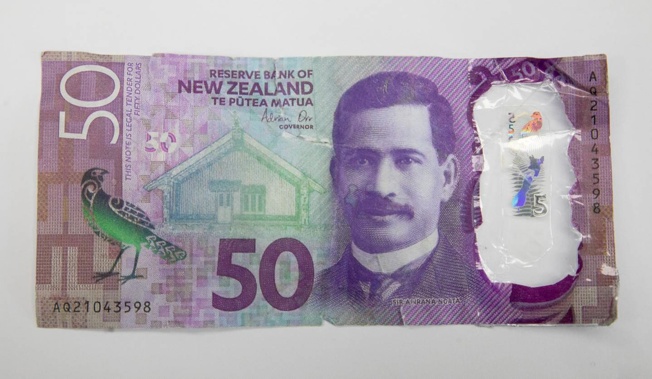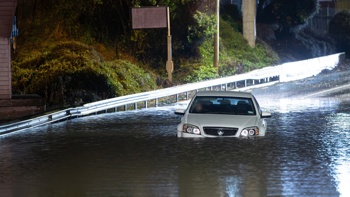
A “shocked” Rotorua bottle store owner is warning other businesses about fake cash he believes is so good that “if you’re in a rush, you won’t know the difference”.
The counterfeit money has also been used in the Western Bay of Plenty where one Pāpāmoa business owner is no longer accepting cash over $50 unless the manager approves it.
Ngongotahā Bottle-O owner Charanjit Dhillon told the Rotorua Daily Post the store was lucky to have been caught out only once with fake money.
It happened two weeks ago and once his staff member realised, Dhillon told the rest of his staff and showed them what to look for.
“I was shocked when I saw it ... this is not on.”
Counterfeit $50 and $100 notes were used and Dhillon said the fake money was paper and the see-through plastic part was cut from a $5 note and stuck on with tape.
“They’ve done a really good job. If you’re in a rush, you won’t know the difference.”
Dhillon is warning other business owners to “be careful” and double-check any cash for the texture, rips, and any differences to real money.
He said many people had since come through trying to use fake notes which the staff have refused.
Bottle-O staff member Namdeep Singh with a counterfeit $50 note. Photo / Andrew Warner
He said when the staff refused, they told the alleged offenders what they were doing was a criminal act.
However, he has not told the police.
Dhillon said he understood it was a problem throughout Rotorua.
A Pāpāmoa business owner, who spoke on condition of anonymity, said counterfeit money “is not acceptable”.
He was part of a business group and said for the past three weeks there had been warnings by other businesses about the fake money which appeared to be “an ongoing problem”.
Last week, he received his first fake cash - two $100 bills. None of the offenders had been caught, he said.
He suspected the money came through between 7.30pm and 8pm when the business was busy and lighting was not great.
“It’s really hard to determine if it’s real or fake especially when [it’s busy].”
The manager discovered the fake cash when he was counting it up and realised something was wrong with the bills which were “very similar” to real money with a bit of sticky tape on each side.
Now, no staff are allowed to accept any cash over $50 until the manager has checked the money.
He said the business would not go completely cashless as it did not want to lose any customers.
He wanted to spread awareness because “the more people that know, the less harm in the community”.
“Please be careful.”
The incident was not reported to the police.
In Rotorua, Natures Superette co-owner Taran Sehmby said she and her husband had not fallen victim to fake money but were closely looking at all the $50 and $100 notes coming through after seeing warnings about it on social media.
Police were approached for comment.
How to spot a fake banknote or coin
The Reserve Bank of New Zealand provides tips online for spotting fake notes and coins: “look, feel and tilt”.
It said there are two series of banknotes in circulation which is Series 6 with small windows, and the newer Series 7 with a large window.
Paper money
Look
Windows: Inside the large, clear window of Series 7 is a hologram with a fern and a map of New Zealand and has the same bird featured on the left-hand side of the banknote. There is also an embossed print note value below the hologram. On Series 6, check the two small windows are intact with a fern in one and the note value in the other.
Does it glow: Forgeries glow under ultraviolet light while genuine notes don’t, except for a fluorescent patch on Series 7 showing the note value.
Microtext: Using a magnifying glass, look at the numeral on the front and back of the banknote. There is microtext including “RBNZ” on the front.
Ink runs: There should not have any blotches or running ink.
Hold it up to the light: The small puzzle pieces on the front and back of a Series 7 note form a complete number. On Series 6, there’s a watermark of the late Queen to the right of the feature portrait.
Feel
The rough: Polymer banknotes have raised printing which can be felt when you run your fingers over them.
The smooth: The notes are smooth and made of one piece of plastic and they shouldn’t tear easily.
Tilt
Tilt: The colour of the bird changes when you tilt a Series 7 banknote, with a rolling bar going diagonally across.
Coins
The RBNZ said fake coins were “extremely rare” which was largely due to the work needed to create a fake coin versus the small reward.
It advised that all designs on a real coin should be clearly defined and it should make “a distinct ‘ring’” rather than a thud when dropped on a table.
The $1 and $2 coins also have special security edging.
Source: The Reserve Bank of New Zealand
Take your Radio, Podcasts and Music with you

/cloudfront-ap-southeast-2.images.arcpublishing.com/nzme/FF6A24EKTZHFDABDUXYDEUZ5XU.JPG)








